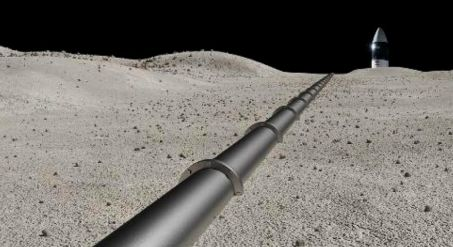Seaplane on Titan, lunar gas pipeline: NASA's futuristic projects
Fourteen potentially revolutionary projects for planetary exploration have just been selected and unveiled by NASA. Among them: a machine that can both fly and navigate on Titan, Saturn's largest moon where conditions could be favorable for the appearance of life.

Artist's impression of the flying boat that could one day fly and sail on Titan
To prepare for the space exploration of the future and to develop avant-garde technologies, NASA has been financing extremely innovative research programs for a dozen years, at the limit of science fiction and current technological possibilities: the " Nasa Innovative Advanced Concepts" ( NIAC ). The idea is to identify and select a series of projects carried out by American companies or research organizations which could, if they are feasible, mark a break in the objectives or the implementation of space missions.
A development in three stages
They are first financed, for a period of nine months, to the tune of 175,000 dollars, in order to formalize concept studies. Those who pass this first stage then benefit from a new grant of up to 600,000 dollars over a period of two years, to draw up a more concrete development programme. The finalists finally benefit from two years of work and additional tests, associated with an envelope of two million dollars. When they come to an end, these pioneering studies thus take place over almost five years.
Make the impossible possible
The 2023 vintage is no exception to the rule. Unveiled on January 9, 2023, it includes 14 of the most daring proposals , such as a seaplane exploring different geological sites on Titan, Saturn's largest moon, a gas pipeline transporting oxygen to the Moon, or even a source of energy much more compact and efficient for space travel. " Nasa dares to make the impossible possible. And that can only be achieved through the thinkers and innovators who help us imagine and prepare for the future of space exploration ," NASA Administrator Bill Nelson said on the occasion. .The NIAC program provides these visionary scientists and engineers with the tools and support they need to hatch the technologies for NASA's future missions ."
Studying the organic chemistry cycle on Titan
Called TitanAir, the "flying boat" project is carried out by the company Planet Enterprises based in Washington. The hull seaplane concept that it developed made it possible both to fly in the thick atmosphere of Titan and to navigate the lake areas of this moon of Saturn, the only star in the Solar System to have lakes and seas in surface even if the latter are not composed of water but of hydrocarbons (methane and ethane). The machine would be equipped with numerous scientific instruments and would carry out exploration missions that could last several hours every day. By analyzing lake and atmospheric samples, he would thus study the cycle of organic chemistry on Titan, which according to certain exobiologists could bring together the conditions necessary for the appearance of life.

Aluminum lunar pipelines
While the Moon has once again become a popular destination for international space agencies and the United States, Europe or China are planning to build manned bases there, the company Lunar Resources , located in Huntsville, Alabama, Imagine for its part gas pipelines to bring oxygen to these permanent stations… But also rovers piloted by astronauts or even rockets! The oxygen would be extracted from the water molecules present at the South Pole of the star Selene in the regolith. It would then be transported, in gaseous form, in networks of aluminum pipelines at least five kilometers long, with a flow of about two kilograms of oxygen per hour.
Artist's impression of a pipeline carrying oxygen to the Moon. Credits: Peter Curreri
Energy sources 1000 times smaller
Finally, let's mention the project proposed by the Rochester Institute of Technology in the State of New York. It aims to revolutionize the technology of "radioisotope thermonuclear generators" (RTG) which have been supplying many NASA space probes since the 1960s such as the Pioneer, Voyager, Cassini or New Horizons vessels, the Viking landers or the Curiosity Mars rovers. and Perseverance. Composed in particular of indium, arsenic and antimony, the new generators could be ten times more powerful (30 watts/kg) than their predecessors because they are much more compact. Their volume would indeed be only 0.2 liters against more than 200 liters currently.
Source : websites

